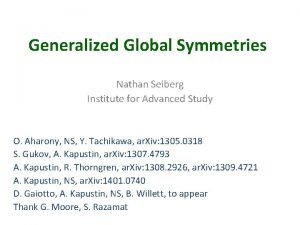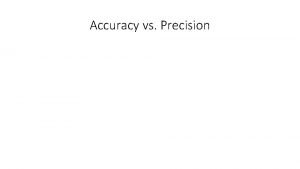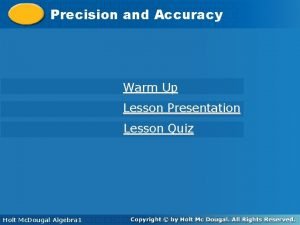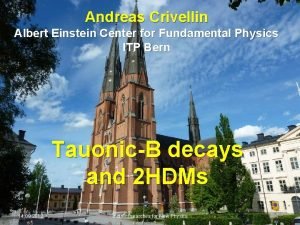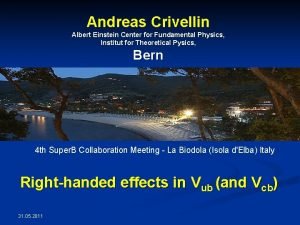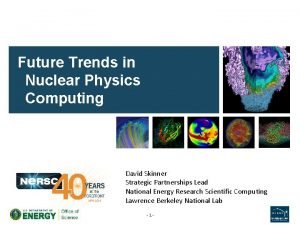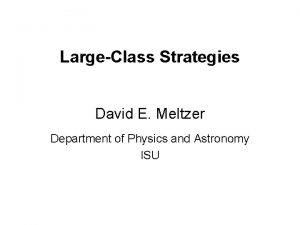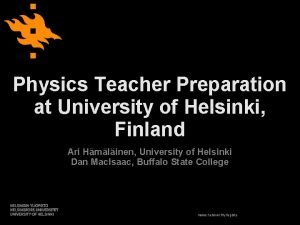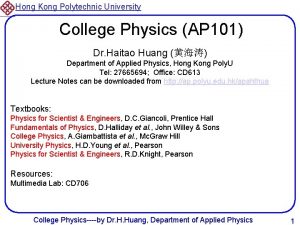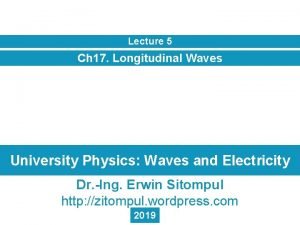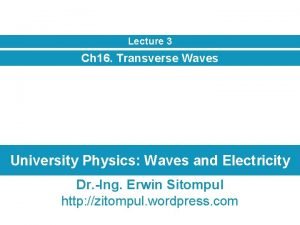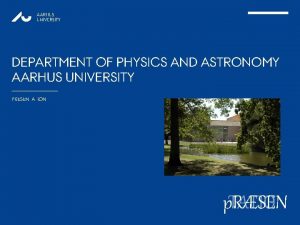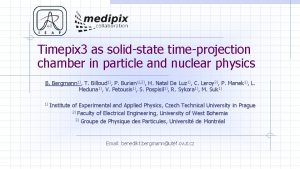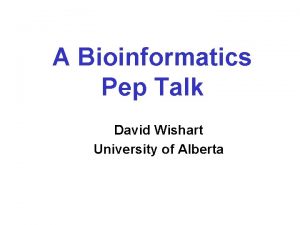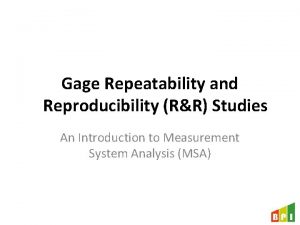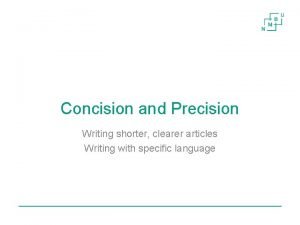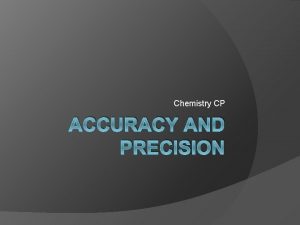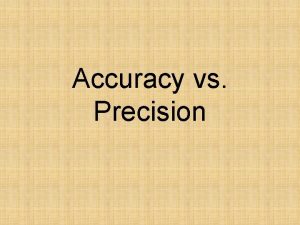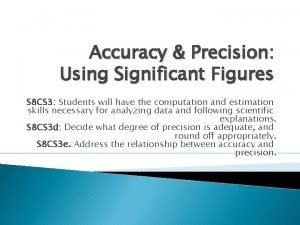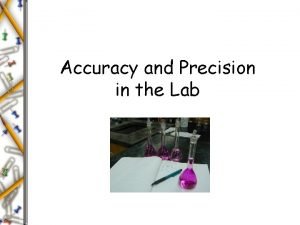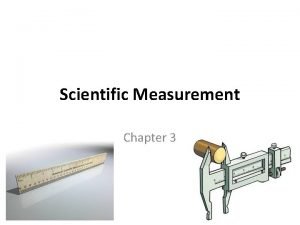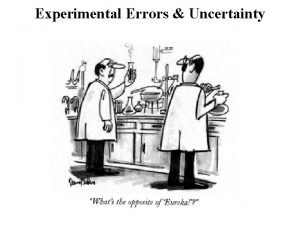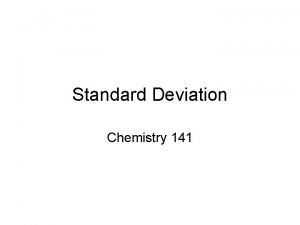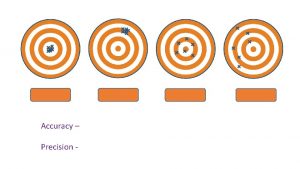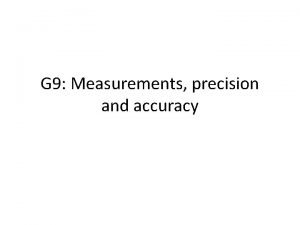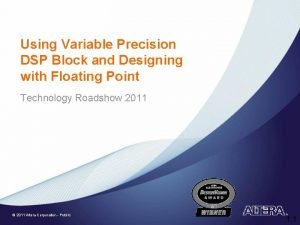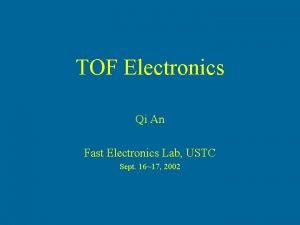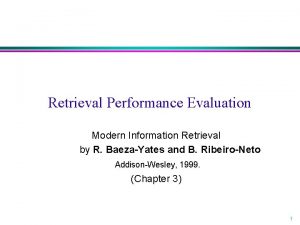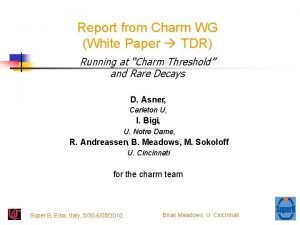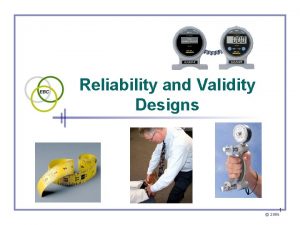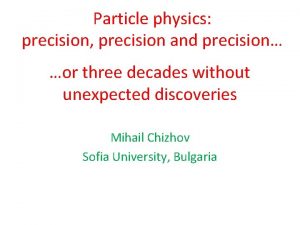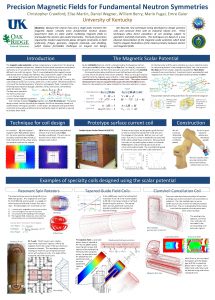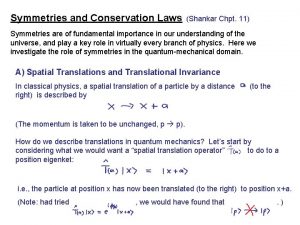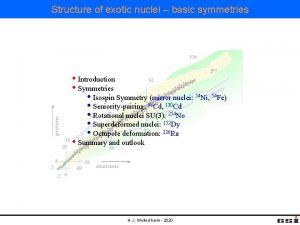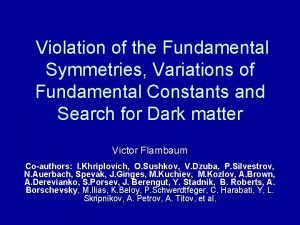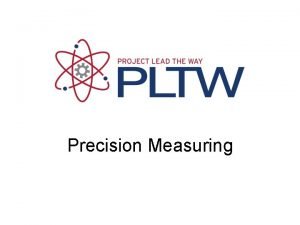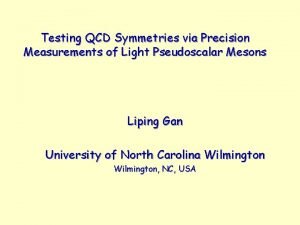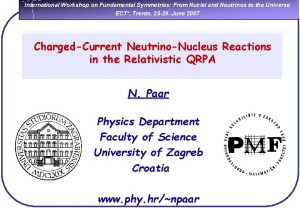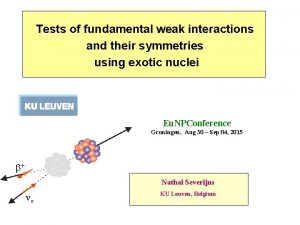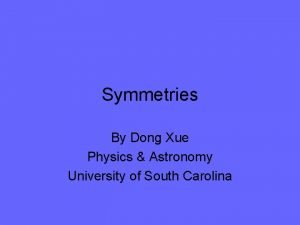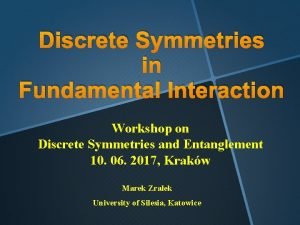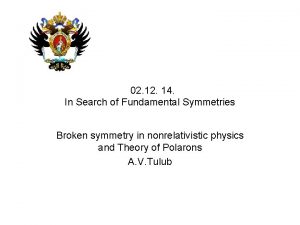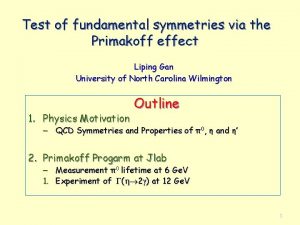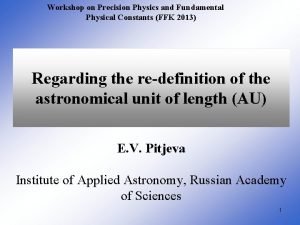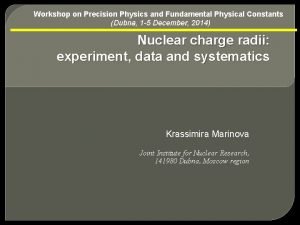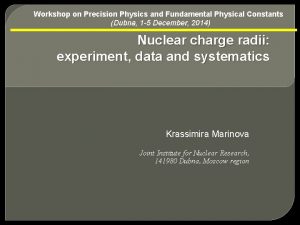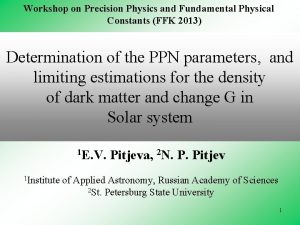Fundamental Symmetries and Precision Physics David Hertzog University


























































- Slides: 58

Fundamental Symmetries and Precision Physics* David Hertzog University of Washington CENPA: Center for Experimental Nuclear Physics and Astrophysics • Lecture 1 • Motivations • Symmetries, Parity, and the Weak Interaction • The Fermi Constant • Muon Decay as a test of V-A theory • Lecture 2 • Neutron beta decay • Parity as a tool to probe matter: PVES • Highly sensitive low-energy probes of New Physics • Lecture 3 (transition here at some point …) • CPV and Electric Dipole Moments • Charged Lepton Flavor Violation • Muon g-2 *With some random experimental details and a modern perspective

Much of the motivation of this field is about looking for New Physics … using low-energy experimental techniques translation: not colliders

My group’s program: An Evolution of Precision Time Mu. Lan Muon Lifetime Mu. Cap p Capture 20 1 3 d Capture Mu. Sun New g-2

Muon Primer • Mass ~ 207 me (50 ppb) • Lifetime ~2. 2 s (1 ppm) Muon – (m /me)2 ≈ 43, 000 times more sensitive to “new physics” through quantum loops compared to electrons (taus would be better!) – High-intensity beams; can stop and study; can possibly collide • Primary production: p+ +n (99. 98%) – Polarized naturally: • Primary decay + e+nen n p+ + (~99%) – Purely weak; distribution in q and E reveals weak parameters • Lepton number is conserved (BRs 4 < 10 -13) + e + n e n

Neutron Primer Neutron • Mass ~ 939. 5 Me. V (6 ppb) • Free n Lifetime ~880 s (we will return to this) • Magnetic moment: -1. 91 N (all “anomalous”) • Electric Dipole moment: < 0. 3 x 10 -25 e cm (we will discuss) • Primary decay n pe-ne (we will also discuss) • Baryon number is conserved

Electron Primer • Seriously ? • It’s light, charged, stable, and we know lots about it electron

The Motivation for Tests of Fundamental Symmetries and the Role of Precision Measurement (the conventional) • Establish the Standard Model parameters and laws. Examples include: – – Masses MZ, MW, MH, mb, mt, me, mu, mv, … Couplings: a. QED, a. Strong, GF, Ggrav Structure of interactions SU(3)Cx. SU(2)Lx. U(1)Y Broad issues • Numbers of generations • Mixing angles, quarks and neutrinos • Lepton number and flavor – Majorana or Dirac neutrinos [ See – Charged Lepton Flavor Violation “NP Role” lectures by Kumar ] • CP violation parameters in K and B sector • The Standard Model as we know it has been built on an enormous experimental foundation involving Precision and Energy frontier efforts • And, some exquisite Theory !

The Motivation for Tests of Fundamental Symmetries and the Role of Precision Measurement (the exotic) • Can we sensitively test the SM limitations to help answer key questions: – Baryon Asymmetry of the Universe – EW symmetry breaking • Are the Standard Model predictions complete? – What is missing? – What extensions are needed? • The community has also begun to worry … Marciano

The unconquered Standard Model Direct approach LHC 7/8 LHC 13 Coming up empty 9 The indirect approach

Discrete Fundamental Symmetries n Parity u Does n Time Reversal u Are n experiment distinguish between left and right? physics processes the same in both time directions ? Charge Conjugation u Do particles and antiparticles behave the same

Combined Symmetries n CP u E. g, Do particles and their antiparticles decay with the same patterns? n CPT u Combination felt to be very solid for any local QM gauge theory. No violations at all sensed. Implications include § § § If CP is violated, T must be violated (a bit of a shock) CPT and Lorentz violation are tested as one Many tests of particle and antiparticle properties, such as magnetic moments of proton – antiproton, electron – positron, muon – antimuon; Lifetimes of particle – antiparticle, and others u Very unlikely to have time for much here, but ongoing efforts exist

Topic 1 A Radical Thought

n A troubling problem was the t+ - q+ puzzle, … well really K+ decay: K+ p + p 0 & K+ p + p Same named q+ t+ particle? parity +1 -1 n Conjecture: two different decay modes of the same particle, with same mass and same lifetime u n Can happen if parity is not strictly conserved This begged the question, “Has parity been checked in the Weak Interaction? ” answer: Not very well

n Then, what would constitute a weak-interaction parity test? u Are muons polarized with respect to their momentum in pion decay? Is the decay pattern of electrons from muon decay non-symmetric with respect to the muon’s spin? Are the decay products from a polarized hyperon non-symmetrically emitted? Is the beta decay of a polarized Co-60 nucleus non-symmetric? u … these are common … u u u § § You need “an axis” to define a direction You need something that is not symmetric with respect to that axis

A flurry of tests begins … Madam Wu’s famous test with Co-60 (in practice, it took the experts at NIST to pull off the key polarization step) Field down Field up When field is up, betas go more “down”; when field is down, betas go more “up”

A flurry of tests begins … Garwin, Lederman, Weinrich follow with muon decay experiment Solid curve is 1 – 1/3 cos q Counts vs. Magnetic Field compared to B = 0

Lee and Yang also suggest that, if PV were so, it offers a natural way to determine the muon’s magnetic moment ! g = 2. 0 ± 0. 1 Spin of is ½ (Dirac, point-like object) And angular distribution proves by theorem here that charge conjugation is also not conserved in WI

Parity violation “at home” At rest, the muon precesses in a magnetic field, giving g, (or the magnetic moment) + g = 2. 1 ± 0. 1 Fitting Error ~ 1. 5 % Magnetic field error ~ 5. 5 % Univ. Illinois cosmic ray setup for undergraduate modern experimental physics course B

Parity Violation appears on all Weak Decays • Leptonic – Muon, tau decays • Hadrons – Kaon, B-meson – Neutron – Nuclei

Weak Interaction Primer* n *I’d love to cite the source I used, but the lovely posted lecture has no name…

Parity & V-A* n Parity transform: n Under P, transform of Dirac equation unchanged u n Eigenvalues of P operator are ± 1 The V-A Interaction (took a while to establish) u u Most general matrix element Ô is combination of g matrices Need combination where charged WI only couples to Left-Handed chiral particles Only the vector (V) and axial vector (A) currents are responsible for PV nature of WI *I’d love to cite the source I used, but the lovely posted lecture has no name…

Parity & V-A* n What we observe is always a square of an amplitude: n Apply a parity transformation (V flips, A does not) n Compare n V-A “violates parity maximally” since both currents have same strength u to . A big difference; the interference term 2 AV c. V =1 and c. A = 1 Weak Charged Current *I’d love to cite the source I used, but the lovely posted narrative has no author listed …

Topic 2 Aspects of the Weak Interaction

Muon Lifetime Fundamental electro-weak couplings GF 15 ppm 0. 5 ppm a MZ 0. 37 ppb 23 ppm Implicit to all EW precision physics Uniquely defined by muon decay q QED Extraction of GF from t : reduced error from 15 to ~0. 5 ppm

From tm to sin 2 θW – Momentum transfer q 2 = (pμ − pνμ)2 = (pe + pνe)2 < mm 2 much smaller than MW 2 – Thus, W propagator shrinks to a point and can be well approximated through a local four-fermion interaction, (Fermi’s original conjecture) GF = (1. 166 378 8 ± 0. 000 7) · 10− 5 Ge. V− 2. (there are further quantum corrections here not included)

Let’s be careful G or GF ? n Lepton Universality is assumed u The bare gauge couplings assumed the same regardless of the lepton involved u And u Is the bare natural relations this really true? And how well do we know it?

Fermi Constants and “New Physics” – W. Marciano Tests Lepton Universality to 0. 2% (much more to this study) There are even more precise limits at ~10 -4

World avg t /t is 18 ppm, but is it right? Lessons from History Precision vs Accuracy + Neutron Lifetime 10 Goal of Mu. Lan is 1 ppm. ± 1 ppm ?

ASIDE: Precision measurements have a checkered history. Before common practice was to ‘blind*’ results tended to have a trend toward an asymptotic value. *If you want me to talk about how to blind experiments, just ask …

Spoiler Alert t(Mu. Lan) = 2 196 980. 3 ± 2. 2 ps (1 ppm) GF = 1. 166 378 7(6) x 10 -5 Ge. V-2 (0. 5 ppm 30

Mu. Lan measured ~ 2 x 1012 decays Number (log scale) Real data Kicker On Measurement Period time Fill Period 5 k. V -12. k. V 12. 5 at PSI Detector has symmetric design around stops

Modern experiments record the complete waveforms using digitizers. Here, 500 MSPS, 8 bit “Now” 800 MSPS, 12 -bit Normal Pulse “artificial” deadtimes >2 x 1012 decays Two pulses close together A difficult fit

If you count 1 when 2 went through, it’s called Pileup Leading order pileup is a ~5 x 10 -4 effect, yet … • Statistically reconstruct pileup time distribution • Fit corrected distribution Fill i+1 1/t – 2/t Normal Time Distribution Pileup Time Distribution This is only the 1 st order effect

34

SYSTEMATICs, SYSEMATICs, and many tests ppm t + Dsecret 22 s Relative t (ppm) tau vs fit start time Red band is the set -subset allowed variance 0 9 s

The analysis is double blinded to avoid biasing the results. Agilent E 4400 Function Generator 1 ct = 2. 217 XXX 2. 21790228 ns f = 451. 0 450. 87649126 +/- 0. 2 MHz Input frequency only known to 200 k. Hz [~ +/- 443 ppm] Fit results reported in terms of a relative secret reference value XXXX ns DR=1 is 1 ppm shift of lifetime

Okay, enough. Unblind it Mu. Lan FAST The most precise particle or nuclear or atomic lifetime ever measured t(R 06) = 2 196 979. 9 ± 2. 5 ± 0. 9 ps t(R 07) = 2 196 981. 2 ± 3. 7 ± 0. 9 ps t(Combined) = 2 196 980. 3 ± 2. 2 ps (1. 0 ppm) Dt(R 07 – R 06) = 1. 3 ps PRL 106, 041803 (2011) Phys. Rev. D 87, 052003 (2013) PSI

From t to GF …

GF & t precision has improved by ~4 orders of magnitude over 60 years. Achieved!

The 1 ppm + lifetime is compared to the - lifetime in gaseous p or d targets to determine the capture rate log(counts) Scale: Example: System Uncertainty (ppm) l+ 1 LS 10 LD 10 + Mu. Lan (complete) -p Mu. Cap (complete) -d Mu. Sun (in progress) m decay time Extract physics here

The singlet muon capture LS on the proton is sensitive to axial nucleon structure LS q q W n e Technique: Precision lifetime measurement in an ultra-pure hydrogen time projection chamber

1 st Precise and Unambiguous Result Verifies Basic Prediction of Low-Energy QCD Physics Axis Mu. Cap is designed to “ignore” this problem Horizontal axis represents some not-well-known Mu-Molecular physics Why do we say the result is Unambiguous ? Phys. Rev. Lett. 110 (2013) 012504

The Structure of the Weak Interaction Is it really only V-A ? (no tensor, scaler terms …) Primary decay + e+nen e+ Angle with respect to (positive) muon spin m+

Final results from TWIST measurement of muon decay parameters Is muon decay purely V-A? Sensitive to attractive SM extensions: L-R symmetric models, which would permit a WR Basic idea: Measure the energy and angular distribution of e+ from + e+nen and compare to Monte Carlo expectations

Even more generally: Muon decay spectrum in greater detail: TWIST experiment where = 0. 7518 ± 0. 0026 = -0. 007 ± 0. 013 P = 1. 0027 ± 0. 0079 ± 0. 0030 = 0. 7486 ± 0. 0028 P ( / ) > 0. 99682 (90% c. l. ) SM 3/4 0 1 3/4 1 45

The formalism, "Michel" parameters Muon decay parameters Differential decay rate vs. energy and angle: (symmetric half shown) Stopped Decay e+

Michel Parameters: TWIST final results SM "SM still okay" ¾ ¾ 1 Results mostly constrain right-handed muon terms Mixing Angle Manifest LRS model Mass m 2 (Ge. V) Generalized LRS model

Topic 3 Parity Violation, the Weak Interaction, & neutrons

The Neutron as a Fundamental Laboratory Neutron beta decay Only 3 parameters needed: Vud, l, f

Dynamics and observables Basic beta decay Lagrangian for a baryon Slides: D. Pocanic

Extracting Vud from n decay Slides: D. Pocanic

Richness in the Neutron Decay Distribution Neutron beta decay measurements give:

Neutron Decay Correlations Nuclear O+ → O+ Decays, CKM Unitarity g. A ? ? ? n Lifetime How thick are the bands and do they overlap ? g. V 53

2007 picture: Lifetime and Correlations combine in a confused picture for the physics of g. A or unitarity Newer Measurements Not consistent PDG 2006 g. A 006 2 G D P X X Newer Measurements J. Nico, 2007

Let’s look at more recent versions of these experiments, but define two “kinds” of n sources Cold and Ultra-cold Neutrons 55

Difficulty is consistency in neutron decay experiments • Lifetime experiments: – Cold “beam” of neutrons … arrange to trap, store, then count the feeble decay protons – Bottled up Ultra Cold neutrons … hold them for a while, dump, and count how many are left • Asymmetry experiments – Cold polarized beam passes through a spectrometer and count the left and right going particles vs. the spin orientation (very few decay, but there are many in the beam) – Ultra-cold polarized neutrons and somewhat similar arrangement, but very few in the “beam” but many decay in the fiducial volume

Modern Lifetime Methods Bottle Keep n away from all walls 1) Gravity (up) 2) Magnetic dipoles (down)

Stopping Point for today
 Cube planes of symmetry
Cube planes of symmetry Nathan seiberg
Nathan seiberg What is non precision instruments
What is non precision instruments Semi precision attachments
Semi precision attachments Single precision vs double precision
Single precision vs double precision University physics with modern physics fifteenth edition
University physics with modern physics fifteenth edition Precision vs accuracy chemistry
Precision vs accuracy chemistry Precision definition
Precision definition Ptc-lms
Ptc-lms Albert einstein center for fundamental physics
Albert einstein center for fundamental physics Albert einstein center for fundamental physics
Albert einstein center for fundamental physics Modern physics vs classical physics
Modern physics vs classical physics Physics ib ia examples
Physics ib ia examples David skinner physics
David skinner physics Protun
Protun Helsinki university physics
Helsinki university physics University physics
University physics University physics
University physics University physics
University physics University physics
University physics Aarhus university physics
Aarhus university physics University physics
University physics Sputonik v
Sputonik v Harris benson physics
Harris benson physics Michigan state university physics department
Michigan state university physics department David phipps york university
David phipps york university Hospital digomi
Hospital digomi David wishart university of alberta
David wishart university of alberta What is precision and recall in information retrieval
What is precision and recall in information retrieval Precision repeatability and reproducibility
Precision repeatability and reproducibility Precision in writing
Precision in writing Precision definition chemistry
Precision definition chemistry Difference accuracy and precision
Difference accuracy and precision Accuracy, precision, and significant figures worksheet
Accuracy, precision, and significant figures worksheet Uncertainty in multiplication
Uncertainty in multiplication Why is it important to defend your faith
Why is it important to defend your faith Poor accuracy good precision
Poor accuracy good precision Quick lab accuracy and precision answers
Quick lab accuracy and precision answers Experimental errors and uncertainty
Experimental errors and uncertainty Brainpop precision and accuracy quiz answers
Brainpop precision and accuracy quiz answers Standard deviation and precision
Standard deviation and precision Passive instruments
Passive instruments Precision and accuracy
Precision and accuracy K h da b d c m
K h da b d c m Accuracy and precision
Accuracy and precision Accuracy vs precision
Accuracy vs precision Brainpop mindfulness quiz answers
Brainpop mindfulness quiz answers 沈榮麟
沈榮麟 Higher precision dsp
Higher precision dsp Qingding precision electronics
Qingding precision electronics Precision optical lab
Precision optical lab Tefal aquaspeed precision
Tefal aquaspeed precision Ti precision labs op amps
Ti precision labs op amps High precision vs high recall
High precision vs high recall Precision paper
Precision paper Reliability coefficient
Reliability coefficient Ti precision labs
Ti precision labs Martin tobin leicester
Martin tobin leicester Precision position
Precision position

